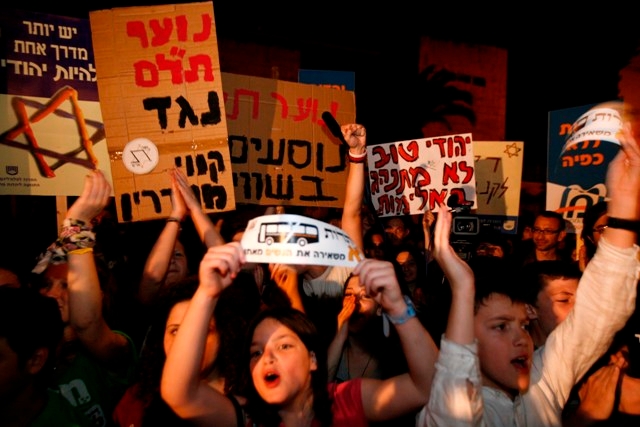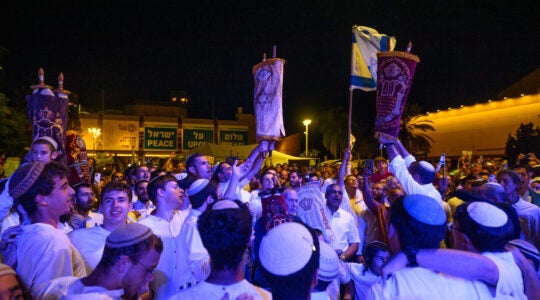JERUSALEM (JTA) – On the No. 3 bus line in Jerusalem, women passengers pay their fare and walk directly to the back to find a seat.
Men, most of them haredi Orthodox with long sidecurls that brush the shoulders of their black wool suits, sit in the front section. Behind them, following a space of about two feet separated by the rear doors of the bus, sit the women and girls.
The Arab driver tersely explains protocol as he begins his route through a string of largely religious neighborhoods toward the Western Wall in Jerusalem’s Old City.
“This is a ‘mehadrin’ bus,” he says, using the term for strictly kosher. “Women sit in the back.”
Even though an Israeli Supreme Court ruling has banned enforced separate seating, this is one of 63 private or public gender-segregated bus lines in Israel, according to Hiddush, an Israeli organization that advocates for religious freedom and equality.
“I wish all lines were like this,” said one haredi woman aboard the bus who appeared to be in her 60s. “This is about modesty and ideally how things should work in the Land of Israel. Chaos follows when men and women sit near one another.”
She added, “Baruch Hashem, maybe this is what will hasten the coming of the messiah.”
The bus lines are one of the more visible examples of the growing segregation of men and women in the haredi Orthodox world, part of the larger, long-running battle in haredi society to keep outside influences at bay.
In Jerusalem, women have been excluded from billboard advertising so as not to offend haredi sensibilities, and a major haredi neighborhood enforced gender-segregated sidewalks over the Sukkot holiday.
Last Friday, hundreds of demonstrators, including Israeli opposition leader Tzipi Livni, protested the exclusion of women from public areas.
“It’s simply become harder to control haredi society now that it has become so big,” said Shahar Ilan, who heads research and public outreach at Hiddush. Increased focus on gender segregation is part of the effort of control, he said.
There long has been strict separation of the sexes in this highly conservative society, from synagogues to wedding halls and schools. But in recent years, gender segregation has grown to encompass more and more public venues. In some Israeli haredi neighborhoods, segregation has extended to sidewalks, grocery store checkout lines, dentist office hours and in some cases even family Shabbat meals.
Some preschools are gender segregated, and one town has separate playground hours for boys and girls. And at a segregated HMO in Jerusalem with separate entrances and waiting rooms for men and women, a posted list of rules advises that girls be examined only by female doctors and boys by male doctors.
Haredi leaders say gender separation is essential for maintaining traditional notions of modesty, and to prevent men from lewd thoughts or actions and protect women from unwanted glances.
The rising number of separated venues has coincided with increasingly “modest” dress — that is, more covering up for women. In some areas, haredi women have taken to wearing a poncho-type garment intended to make the female form as shapeless as possible. In the Jerusalem suburb of Ramat Beit Shemesh, a few women have donned full-body burkas that cover even their faces.
To be sure, there is great variation within the vast camp of religious Jews known in Israel as haredim — a term that means “those who tremble” before God.
For example, on the most austere and stringent side, among the Gur Chasidim, married couples do not walk together in public and young men are discouraged from conversing with their brothers’ wives. Among the more liberal sects, married couples sit together on buses, and many privately express their discomfort with the widening gender gap.
Kimmy Caplan, a professor of Jewish history at Bar-Ilan University who researches haredi society, said the trend toward gender separation is partly a response to the growing number of haredi women entering the workforce.
“They are meeting all kinds of people, and some haredi leaders see this as dangerous,” Caplan said. “It has the potential, as far as some leadership sees it, to be a danger because it can bring home questions, doubts, exposure to alternative ways of life.”
He explains that “There are certain leaders who think there is a need to create a balance by having more segregation in the neighborhood to compensate for a drop of segregation by women going out to work every day.”
It wasn’t always like this, scholars note. In Europe before the war, haredi women didn’t always cover their hair, and in photos of Agudot Yisrael youth groups from that period, teenage girls and boys can be seen together, Caplan said.
Naomi Ragen, an American-born Israeli novelist who is Modern Orthodox and writes about the Orthodox world, has been an outspoken opponent of gender-segregated buses ever since she was threatened verbally on a bus in 2004 when she refused to move to the back with the rest of the women.
Ragen later was among the plaintiffs in a lawsuit by the Israel Religious Action Center, the advocacy arm of the Jewish Reform movement, against the Israeli Transportation Ministry and bus companies that operate segregated bus lines. The lawsuit, heard by the Supreme Court, resulted in a ruling that such buses are illegal but that voluntary segregation could not be banned.
Since the ruling, signs must be posted on mehadrin buses stating that it is illegal to force anyone to move from their seat.
“The changes in Orthodoxy since the time I accepted it as my way of life have been unbelievable,” said Ragen, who became Modern Orthodox some 50 years ago. “It’s day and night from what I see today. My theory is the rise of Muslim fundamentalism as a patriarchy-influenced Orthodox patriarchy.”
Ragen says she sees the trend as part of a broader process of extreme behavior employed by haredim, such as rioting at a municipal parking lot in Jerusalem that was opened on Shabbat. She says the clashes have more to do with internal power struggles and an attempt to sideline women than piety.
“Few people are involved in this radicalization; most of the people in Mea Shearim, for example, are removed from it,” she said, speaking of a large haredi neighborhood in Jerusalem. “It is just unfortunate that a great majority of people in the ultra-Orthodox world that are good and straight people are being bullied and battled by a vocal minority that has nothing do with Judaism, holiness or the Torah.”
One woman who agreed to be interviewed on the condition that she be identified only as Hannah became a plaintiff in the lawsuit against segregated bus lines after she was verbally harassed and threatened for not moving to the back of a bus. She says she still worries that the men who threatened her will make good on their pledge to “track her down and deal with her.”
“I am a 60-year-old woman and was told I was sitting up front because I wanted to flirt with men,” Hannah said. “I was told that I was the reason the messiah was not coming and I was doing something vile by not moving.”
She says other haredi men and women have approached her to express sympathy, but fear that if they speak out against the extremism they and their families will face negative consequences.
The Israeli Religious Action Center says gender segregation is being used to suppress women.
“The term ‘gender segregation’ does not refer to a system that divides public space into two equal halves, maintaining equal access for both sexes,” said a report on haredi gender segregation by the organization. “Almost invariably it entails the displacement of women and their removal from the public realm.”
But for women like Rivkah (not her real name), a 20-year-old from the Vishnitz haredi sect who was riding the No. 3 bus to the Western Wall to pray ahead of her upcoming wedding, separate seating was a comfort, not an affront.
“It’s not extreme,” she said. “The temptations men feel are great, and it’s hard for them not to look at women. Sitting separately helps them not to look.”
In her community, interactions between the genders are highly regulated. She will be marrying a man she met once for an hour after their respective families extensively researched their backgrounds and suitability.
“And I won’t see him again until the wedding,” she said before disappearing into the crowded women’s section of the Western Wall.
JTA has documented Jewish history in real-time for over a century. Keep our journalism strong by joining us in supporting independent, award-winning reporting.






